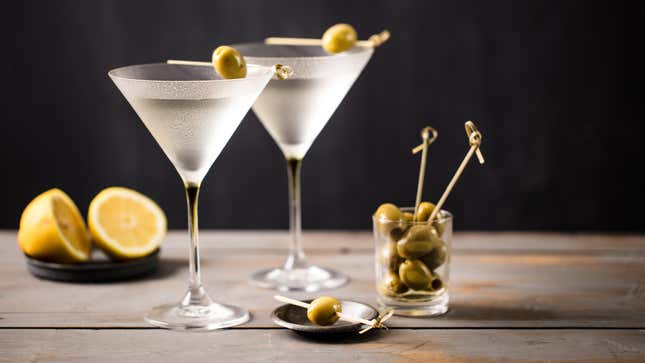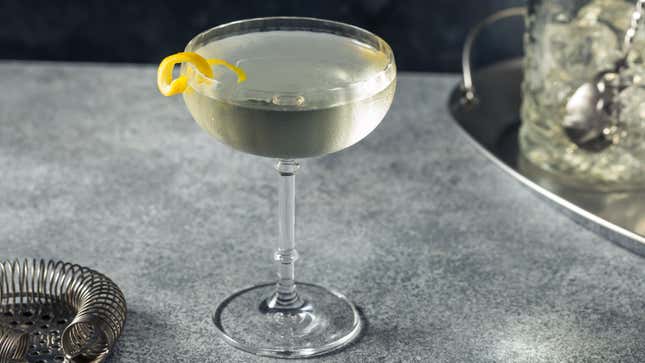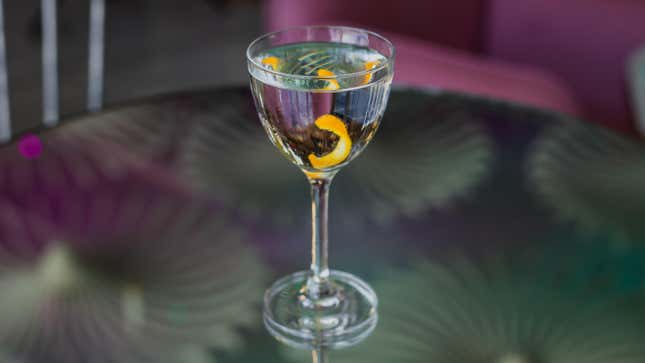
Every time you order or make a martini, you are presented with choices. Gin or vodka? (Gin, make it with vodka and that’s a Kangaroo.) Shaken or stirred? (Stirred, unless you like an aerated, watery martini.) Olive or twist? Dry, classic, or dirty? Then there is the matter of glassware. If you’re at bar, you probably don’t get to choose, but stocking your home bar is a different situation.
Coupes, Nick & Nora glasses, and the classic martini glass are the three main options. It mostly comes down to personal preference, but understanding the history of each glass, and the physical realities of each shape, can help you make the right choice for your perfect martini.
How the martini glass came to be
There are two things that factor into one’s regard for the steep-sided, v-shaped martini glass: perception and physics. Depending on when you started drinking, you might regard the glassware as an iconic throwback to a more dapper time, or the mere sight of one might flood your palate with the ghosts of the violently vibrant ‘tinis of the ‘90s (lemon drops, appletinis, and the like).
But the martini glass didn’t always house martinis. According to PUNCH, it was introduced at the 1925 Paris Exhibition as a modernist, art deco-inspired take on the coupe. Like the coupe, it was commonly used to serve champagne, or at least that’s how it was depicted on the silver screen.
The martini (and gin in general) began to peak in popularity around that same time, thanks to Prohibition. An affinity for angular designs in architecture, furniture, and home goods helped boost the slanted glass’s popularity, and drink and vessel were cemented as a pair. The glass is now more likely to be associated with the ad men of the ‘60s, stock market bros of the late ‘80s and early ‘90s, or the classic cocktail resurgence of the mid 2000s. No matter what era you associate it with, you cannot deny the aesthetics. Martini glasses look how a martini tastes: sharp, iconic, and a little bit brutal.
What it’s like to drink from a martini glass
Drinking from a classic martini glass can get a little sloshy, thanks to its wide bowl and slanted sides, but sloshiness is affected (for better or worse) by the size of the glass and angle of its sides. I have some vintage martini glasses that are huge, wide, and impossible. I keep them around because I like looking at them, but I almost never drink from them. (They’re decorated with little skewered olives in relief.)
But a more narrow martini glass, with a thin edge, can be a beautiful thing. If feels delicate on the lip, and its sloped side lets the cocktail flow, unencumbered, onto the tongue. It’s less flat than the coupe but more narrow than the Nick & Nora, and can trap the botanical aromas of the gin without interfering with the flow of the liquid.
Highly-rated martini glasses of various sizes:
- Milan 7-ounce martini glasses, set of 4
- Glassique Cadeau 5-ounce martini glasses, set of 6
- Lenox Tuscany 10-ounce martini glasses, set of 4
It’s also a glass that separates skilled martini sippers from plebes, demanding a certain competence and elegance on the part of the drinker. Getting sloshed without sloshing is the mark of mature imbiber, and drinking from a martini glass is like riding a bike without the training wheels offered by the more rounded coupe, or the deeper Nick & Nora.
If you’re looking to buy a martini glass or two, look for glasses with more acute angles, and consider the size thoughtfully. A four-ounce glass has plenty of room if you’re a skilled martini drinker; a good martini is rarely over three or four ounces, and glasses should never be filled to the brim. Overfilling is how sloshing happens. (This glass from John Jenkins is my platonic ideal of a martini glass, though they can be difficult to source if you’re not ordering for a bar, so grab similar looking glasses if you see them out in the wild.)
A coupe glass is a little more all-purpose

The history of the coupe glass is flirty and fun, if (most likely) historically inaccurate. It’s said to have been modeled after a breast, either that of Madame de Pompadour or Marie Antoinette, making for a rounded, cute and perky glass. (It’s a good thing those women were A-cups; a glass molded after my boob would hold enough gin to kill Gatsby himself.)
Highly-rated coupe glasses that may or may not resemble famous breasts:
- Cocktail Kingdom® Leopold® 6-ounce coupe glass, set of 4
- Viper Kitchen 5-ounce coupe glasses, set of 4
- PURE MORA 7-ounce coupe glasses, set of 4
- Say Ho Hum 4-5-ounce coupe glasses, set of 6
According to APOLLO magazine, the coupe was the original vessel of choice for Champagne (back when the French weren’t such huge fans of bubbles in their wine), with wide mouth that discouraged effervescence while letting the drinker knock ‘em back with ease and enthusiasm. (The glass shape, however, dates back to a time before sparkling wine, as far back as the 4th century BC, by some accounts.)
Regardless of exactly where the coupe got its shape, it’s the most all-purpose cocktail glass you can stock in your home bar. It’s a great vessel for martinis, but also margaritas, daiquiris, and Manhattans. I could list the virtues of the glass, but my favorite bartender, Dan Casto, already did that, so let’s revisit what he said back then:
Cocktails, properly mixed by someone who knows what they’re doing, come to you balanced, perfectly diluted, and cold as hell. The mixer has carefully added the correct amount of water by shaking or stirring, so you don’t want to mess that up with extra ice, or warm it up by getting your grubby hands all over it, which is where the stem comes in. Generally speaking, you also want a coupe that is a bit larger than the total volume of your drink. This prevents spillage, and also aids in harnessing aromatics, be they naturally occurring in your chosen spirits, or added via a citrus twist, an absinthe rinse, or a couple drops of orange blossom water (a very tasty trick for all manner of sours).
Picking a good coupe requires, again, thinking about dimensions and shape. Just like breasts, not all coupes are shaped the same, and width, curve, and depth can all affect flavor. A deeper bowl, when not filled to the brim, will capture aromatics more efficiently than a shallow, flat bowl, but go too narrow and it can affect the flow of the drink as it makes its way to your mouth.
The Nick & Nora is practically un-sloshable

While the glass gets its name from Nick and Nora Charles, a detective and his wealthy wife around which the 1934 novel The Thin Man and film of the same year and title is centered, the glass wasn’t referred to by either name until 1987. According to Vinepair, it was bartender Dale DeGroff who gave the glass its name, after being appointed as head of the newly re-opened Rainbow Room in the late ‘80s.
Highly rated Nick & Nora glasses that Nick and Nora would love:
- Riedel Nick & Nora glass, set of 2 (Full disclosure: Riedel sent me a pair to try, and I love them.)
- Bormioli Rocco Novecento Stemware Nick & Nora glass, set of 4
- GLASSIQUE CADEAU Art Deco Nick & Nora glass, set of 4
DeGroff shunned the large, straight-edged martini glasses the time, and searched for the smaller, deeper cocktail glasses he had seen in The Thin Man and its sequels. (It is worth noting that Mr. and Mrs. Charles drink from many different types of glasses, but DeGroff had a particular shape in mind.) His enthusiasm for vintage glassware that would match the classic cocktails he wanted to serve led to him scour a vintage cocktail catalogue, with the understanding that the glass he was searching for would probably have to be newly molded and manufactured, as such glasses were no longer in production. He found the a “Little Martini” glass in the old book, ordered it, and referred to it as the “Nick & Nora” from then on out. The name stuck, and “Nick & Nora” now refers to small cocktail glasses that are tulip shaped, with narrow, deep walls.
It’s nearly impossible to spill a martini when drinking from a Nick & Nora, but the glass has other benefits. Audrey Saunders, a mentee of DeGroff and noteable bartender in her own right, told Vinepair that the narrow shape creates a more aromatic and delicious martini-drinking experience:
One of the most important benefits is its smaller circumference,” says Saunders. “Having a tighter bowl with straighter sides than the traditional Martini glass allows it to accentuate the aromas in aperitif cocktails off its more erect sidewalls, thus enhancing the overall flavor of the cocktail.
The shape is also thought to keep the cocktail colder for a longer period of time, as less of the liquid is exposed to the warmer air.
In truth, there is no “wrong” glass for your martini. I’ve been known to consume them in a big ol’ wine glass (if I’m enjoying an “inverted martini”) or in a rocks glass (for the 50/50). A narrow bowl may “capture” the aromatics a little more efficiently, but I’ve had wonderfully aromatic martinis served to me in both coupes and martini glasses, without any perceived detriment to the flavor.
It all comes down to how you want to stock your bar, and the vibes you want to cultivate. The more universal coupe gets you a little more bang for your buck, and the Nick & Nora lets you serve a similarly wide range of cocktails with truly retro flair, but there’s no law that says you can’t serve a margarita in a martini glass. That would be quite the power move, now that I’m thinking about it, and a martini is powerful drink.